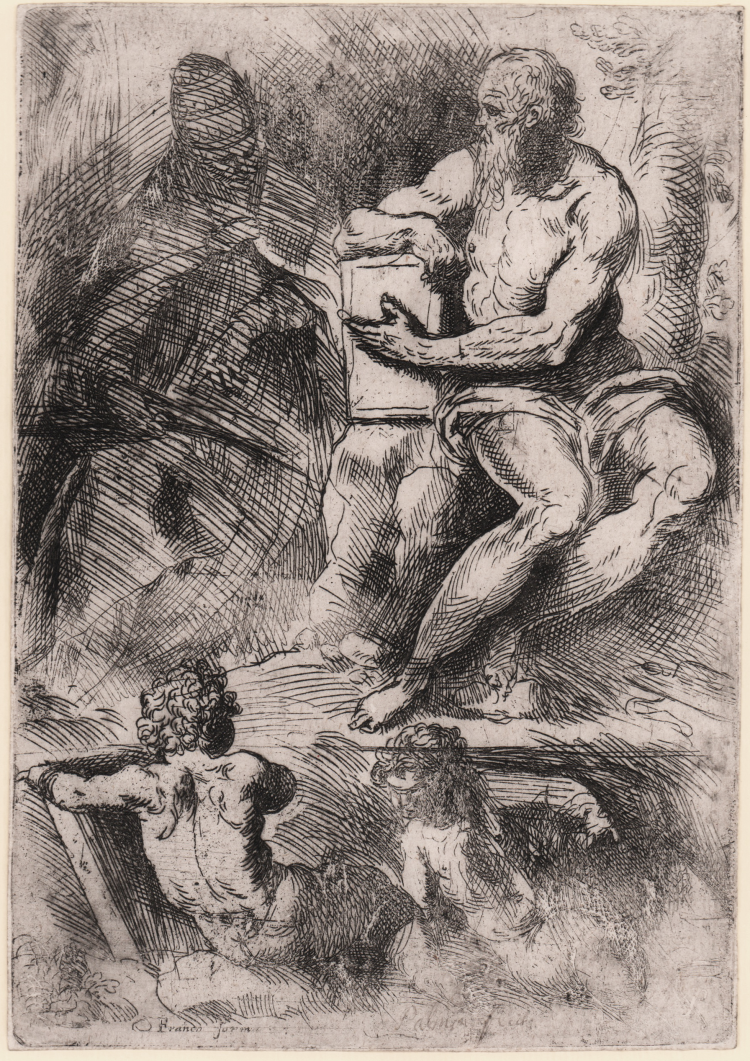




| Reference: | S22130 |
| Author | Jacopo PALMA detto "Palma il Giovane" |
| Year: | 1611 ca. |
| Measures: | 168 x 110 mm |



| Reference: | S22130 |
| Author | Jacopo PALMA detto "Palma il Giovane" |
| Year: | 1611 ca. |
| Measures: | 168 x 110 mm |
Sheet of studies with St Jerome seated in the upper right, two putto below and a male figure wearing a crown in the upper left
Etching and engraving, 1611 circa, Lettered lower left 'franco forma' and 'P' at right.
Magnificent work, printed on contemporary laid paper with thin margins, in excellent condition.
From the De excellentia et nobilitate delineationis libri duo, published in 1611. This is a title page for a pattern/model book which provided images students could copy. It was probably never intended that it be published as a bound compilation, the prints it contains are of very different subjects and sizes.
Belonging to an artistic family, Palma was immediately sent to be trained as a painter like his father’s uncle, Palma the Elder and his mother’s brother, Bonifacio de' Pitati. The influence of Raphael and Tintoretto was very strong during his training; he realized many copies after Titian, his real master, with whom he worked also on the famous painting La Pietà. He developed his artistic skills at the Venetian school and in Rome, where he lived for four years and came to know the Mannerism. His personal artistic production started in 1565.
From a graphic point of view, Palma owes his fortune to the publisher Giacomo Franco, son of Battista Franco. His graphic work is all collected in his De excellentia et nobilitate delineationis libri duo, 1611, published by Franco. The treatise includes some anatomic studies realized with etching and engraving carved by Jacopo Palma and, in the second book, studies of cameos, reliefs, old style decorations, engraved by Battista Franco and probably revised by his son.
|
Bartsch XVI, 16 e 20; S. Mason Rinaldi, Palma il Giovane. L'opera completa, pp. 46, 58, 101, 105. Dimensioni 145x205.
|
Jacopo PALMA detto "Palma il Giovane" (Venezia 1544 -1628)
|
Venetian painter and etcher; great-nephew of Jacopo Palma I, called Palma Vecchio. The influence of Raphael and Tintoretto was very strong during his training; he realized many copies after Titian, his real master, with whom he worked also on the famous painting La Pietà. He developed his artistic skills at the Venetian school and in Rome, where he lived for four years and came to know the Mannerism. His personal artistic production started in 1565.From a graphic point of view, Palma owes his fortune to the publisher Giacomo Franco, son of Battista Franco. His graphic work is all collected in his De excellentia et nobilitate delineationis libri duo, 1611, published by Franco. The treatise includes some anatomic studies realized with etching and engraving carved by Jacopo Palma and, in the second book, studies of cameos, reliefs, old style decorations, engraved by Battista Franco and probably revised by his son.
|
|
Bartsch XVI, 16 e 20; S. Mason Rinaldi, Palma il Giovane. L'opera completa, pp. 46, 58, 101, 105. Dimensioni 145x205.
|
Jacopo PALMA detto "Palma il Giovane" (Venezia 1544 -1628)
|
Venetian painter and etcher; great-nephew of Jacopo Palma I, called Palma Vecchio. The influence of Raphael and Tintoretto was very strong during his training; he realized many copies after Titian, his real master, with whom he worked also on the famous painting La Pietà. He developed his artistic skills at the Venetian school and in Rome, where he lived for four years and came to know the Mannerism. His personal artistic production started in 1565.From a graphic point of view, Palma owes his fortune to the publisher Giacomo Franco, son of Battista Franco. His graphic work is all collected in his De excellentia et nobilitate delineationis libri duo, 1611, published by Franco. The treatise includes some anatomic studies realized with etching and engraving carved by Jacopo Palma and, in the second book, studies of cameos, reliefs, old style decorations, engraved by Battista Franco and probably revised by his son.
|